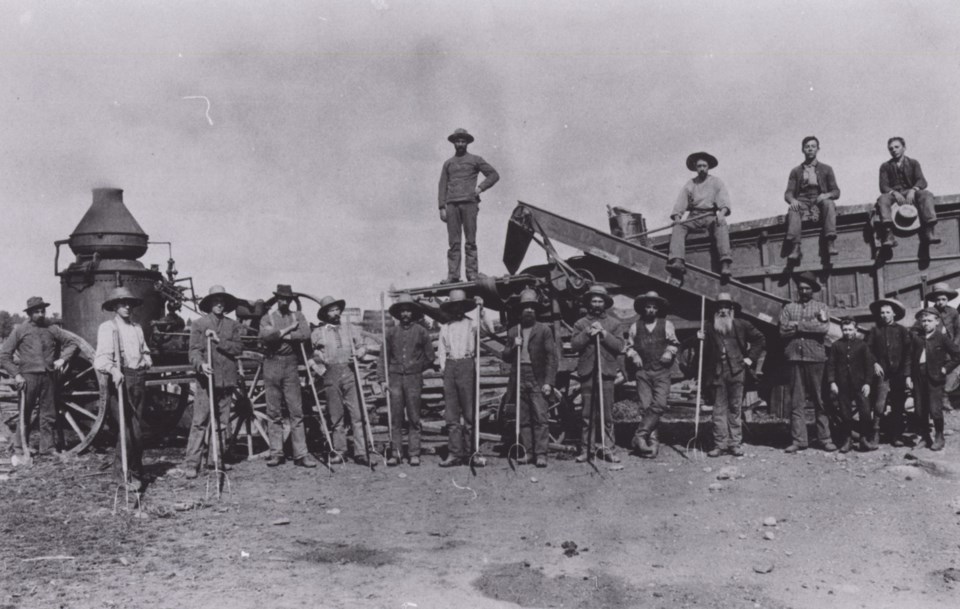Mixed farming was the norm in much of Ontario until the Second World War, so most farmers would have grown a variety of grains — including barley, buckwheat, oats, and wheat — that required threshing to separate the grain from the shocks.
North America’s first settlers would have done threshing by hand, placing a layer of sheaves down on the barn floor and beat it repeatedly with hand flails. Threshing this way would take days to complete, and at the end of each day the farmer would be exhausted, drenched in sweat, and covered head-to-food with a layer of white dust that made him appear like an apparition.
Then, around the turn of the 19th century, came a revolution: threshing machines.
Early threshing machines were hand-fed and horse-powered. By the middle of the century most were steam-powered (such as that pictured here), driven either by a portable engine or traction engine.
To get an idea of just how revolutionary the threshing machine was we can look to Britain. The widespread use of threshing machines turned thousands of men of out work; whereas before threshing required numerous farm labourers, now only a few were required. In 1830 rural workers had had enough. With their jobs and way of life threatened, they rioted in The Swing Riots, smashing threshing machines and threatening farmers who had them.
But time doesn’t stop or move backward. It doesn’t work that way. Threshing machines were embraced by farmers, both in Europe and in North America.
Threshers were expensive, however, and not pieces of equipment everyone could afford. Instead, an enterprising man would buy the machine and rent his services out to area farms. Every day through the autumn, the owner would take his thresher to a new farm, pulled either by a team of horses or a steam tractor.
Early threshing machines were hand-fed and horse-powered. By the late 19th century most were steam-powered, driven either by a portable engine or traction engine.
There were three stages to the operation of a threshing machine.
First, bundles of grain and straw were pitched into the feeder, or hopper. The feeder controlled the rate of feed passing into the machine to prevent overloading. Threshers were efficient and fast, so keeping up made for a tiring day of aching arms and backs.
Next the separator, a rapidly rotating set of blades, tore the bundles apart, breaking the twine and snapping the heads from the straw. The separator also removed most of the straw from the kernels. Passing through a series progressively smaller shaking screens, the chaff was removed from the kernels (thus the term, ‘separating the wheat from the chaff’).
Finally, the kernels passed into the cleaner wherein a stream of air that blew the remaining straw and chaff away (those operating on this end of the machine ended the day particularly dirty, mouths desert and noses clogged with dirt and straw — not pleasant). The cleaned kernels then fell into a hopper, while the straw and chaff were blown out onto the straw stack by a larger, stronger blower.
Threshing machines represented a revolution in agriculture. Originally reviled by some, they became an accepted and even vital part of the rural way of life.



